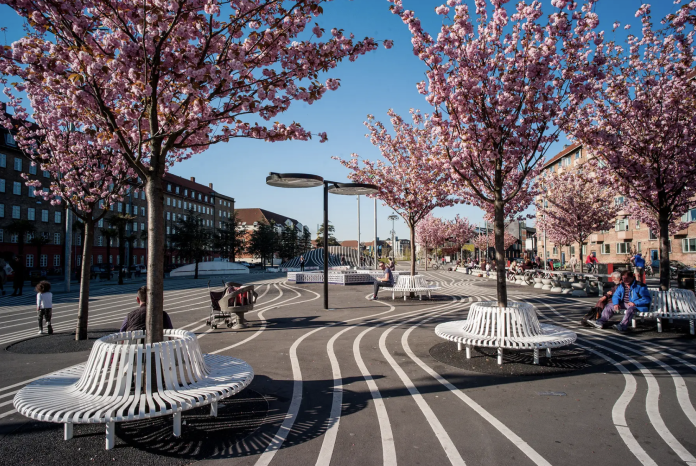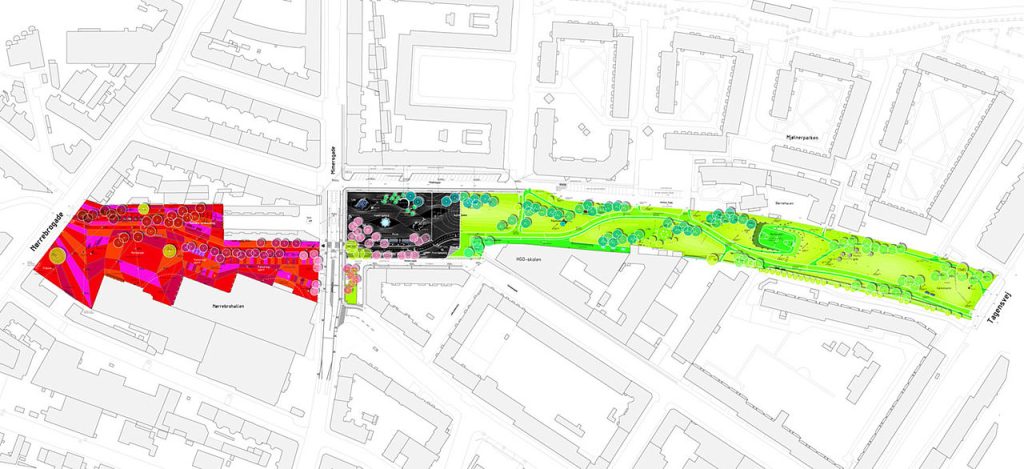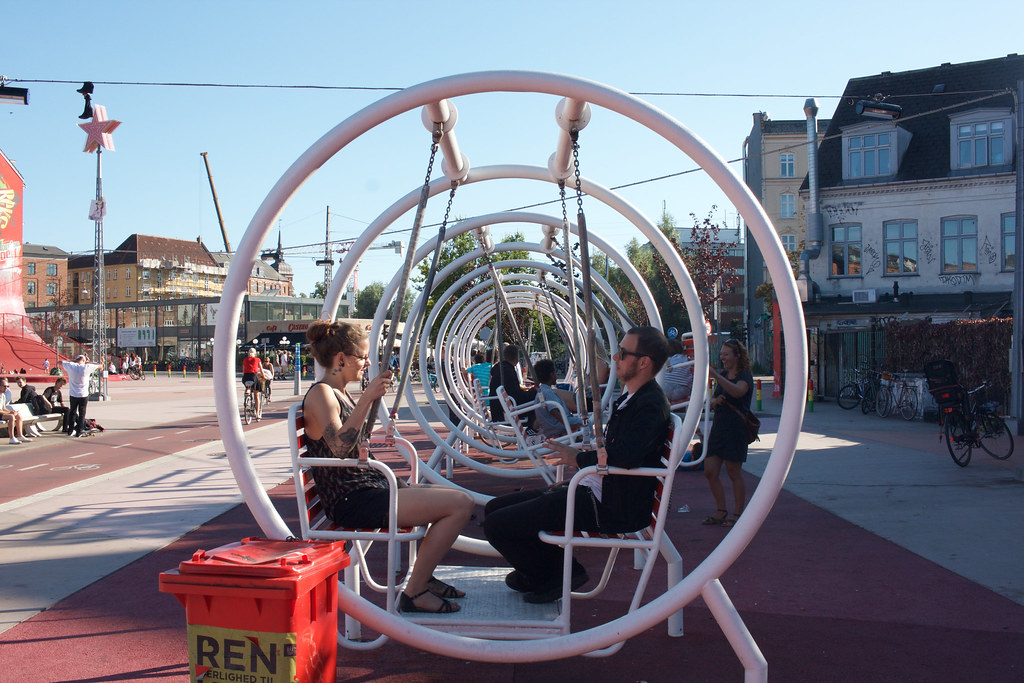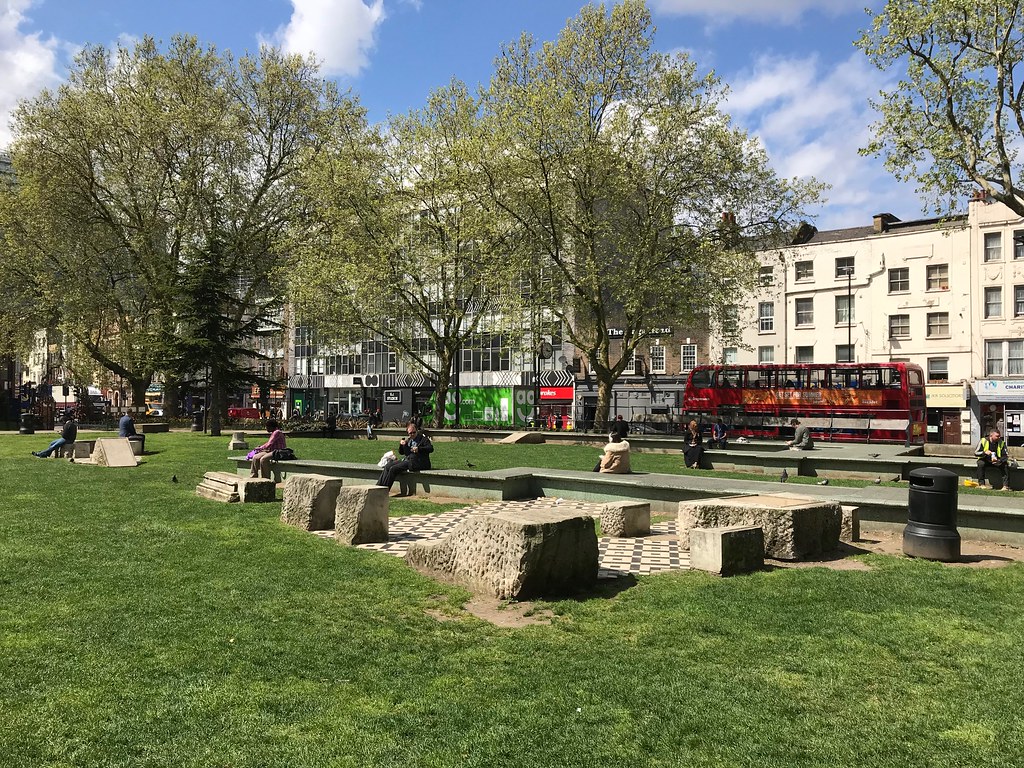
People seldom associate Copenhagen with urban strife, but before Superkilen was completed in 2012, Nørrebro was known as one of the most dangerous areas of Copenhagen. Gangs made up of people from different ethnicities and backgrounds would often clash there, giving the area the reputation of being unsafe and violent. A neighborhood in constant conflict is not sustainable for the future, no matter how environmentally friendly it may be. To make Nørrebro a better and safer place for its residents, the city of Copenhagen chose to invest in a novel solution that would come to be known as the Superkilen.
Superkilen is a public space in Copenhagen designed by Bjarke Ingels Group (BIG) in collaboration with Superflex Landscape Architects and Topotek1. The project was completed in 2012 on a half-mile-long “wedge-like” site — hence the name since kilen means wedge in Danish — in Nørrebro, one of the most ethnically diverse areas of Copenhagen.

While some firms may have seen its bad reputation as a reason to avoid the area, BIG saw it as an opportunity to create change and togetherness in the community. They set out to design a public space that displayed different cultures in a positive light, where the community could meet and learn about their differences. To achieve this, Superflex deployed teams across the world to retrieve items suggested by residents to be included in the space. Over 60 different nationalities would come to be represented in the park.

The result? Superkilen is now home to a boxing ring from Thailand and bar tools from Brazil among other things. To create this super culturally diverse environment, the designers literally took objects from all over the globe and brought them to the Superkilen. Thus visitors can play basketball on hoops brought from Mogadishu, Somalia, relax next to a star-shaped fountain from Morocco, work out on exercise equipment from Muscle Beach, California, or watch their children play on an octopus slide inspired by Japan.
The Superkilen project has helped create a more harmonious community in Nørrebro where different communities and cultures can co-exist, giving the area a great foundation to develop into an environmentally sustainable community. But it also created one of the world’s finest examples of the concept of Just Sustainabilities.
Traditionally when people think of the word sustainability, it is most often associated with the notion of renewable energy and the environment. However, when sustainability becomes plural it takes on a different meaning and concept.
Popularized by urban planner Julian Agyeman in the 2000’s, the Just Sustainabilities concept argues that development of environmentally friendly infrastructure can sometimes create more discrimination. While gentrification of less desirable areas and moving towards “smart” cities has positives when it comes to environmental factors, many social barriers can be created when new spaces cater to certain demographics such as higher income individuals or families. Barriers to entry such as rising property prices in these developed areas can drive away certain groups making such areas less diverse.
To remedy this problem, Just Sustainabilities aims to work alongside the usual policies and developments associated with sustainability while creating a higher standard of living for all people in the present that will still hold up for future generations. The concept aims to create diverse and inclusive infrastructure that coincides with the ideals of eco-friendly areas. Social welfare and quality of life are just as important for the future as renewable energy and reduced emissions if we are aiming to build for the future.
The Superkilen is not the only example of the Just Sustainabilities concept at work. London, England’s “Altab Ali Park” is another fantastic example. Constructed in 2011, Altab Ali Park shares its name with the victim of a racially motivated murder in May 1978 on a street adjacent to the current location of the park. The park now often plays host to public speeches, political debates, and peaceful protests where different communities can share their views with others in a space shared by all. Like the Superkilen, Altab Ali Park features items that represent the community it is situated within, creating a space that portrays the diversity of the neighborhood.

Traveling across the Atlantic, BIG once again designed with Just Sustainabilities in mind with the development of Manhattan’s “The Big U.” Due to be completed in 2026, The Big U is a 10-mile-long park that is set to run along the banks of Hudson creating a barrier that will protect lower Manhattan from floods.
The project was devised as a direct response to the devastation caused by Hurricane Sandy and the damage it caused, especially low-income neighborhoods that struggled to recover. The park will respond to specific neighborhood needs and add much needed amenities requested by the communities it surrounds. The Big U will create much needed social spaces that represent the areas it affects and connect different groups that were previously isolated socially.
Examples like the Superkilen, Altab Ali Park, and Big U show us how designing with people in mind using the Just Sustainabilities framework puts social welfare and diversity at the heart of new environmentally friendly places. The result is exciting new urban places that everyone can enjoy.

Zac Fleming (Guest Contributor)
Zac Fleming is an Architecture student at Sheffield Hallam University, hailing from Wakefield, England. Now living in Sheffield, he heavily focuses on urban design and walkability throughout his projects. When not at university, Zac can be found playing guitar on stage with his band, or exploring Sheffield’s leafy suburbs and Peak District.
